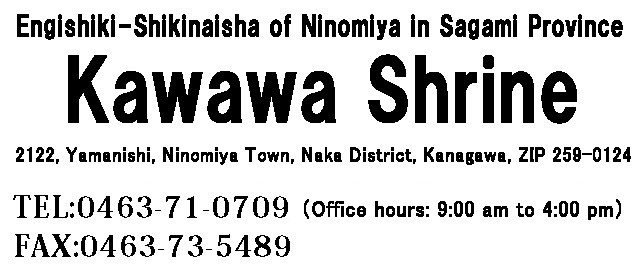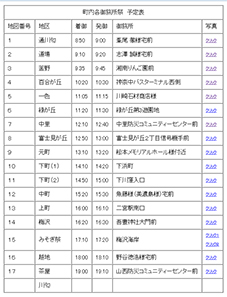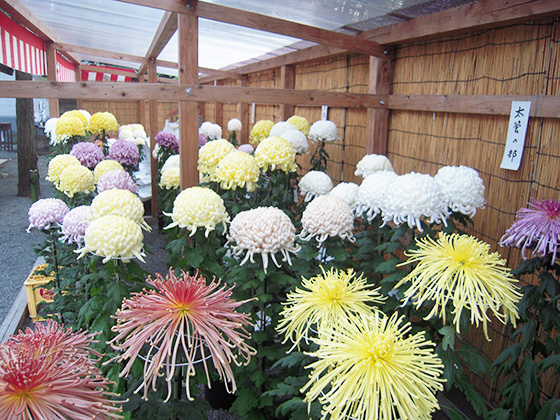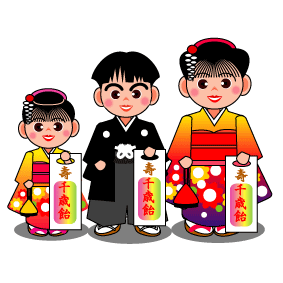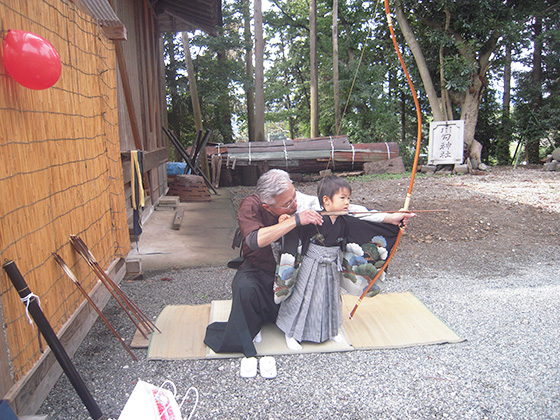Annual Events
Chrysanthemum Show |
Making of Chimaki (steamed rice dumpling wrapped in cogon leaves) for Sagami Province Kounomachi (Provincial Capital Festival) |
Setsubun-sai |
| Every year on the 3rd of February, events such as the Tsuinashiki festival to drive away oni (demons), the Onioi ritual and Kaminigiwai events are held. Approximately 1,000 roasted soybeans, called fukumame, are scattered, and you can win luxurious prizes. |
|
Tsutsugayu-sai is one of our shrine's traditional rituals. It is unclear when Tsutsugayu-sai began, but this Shinto ritual was mentioned as one of Kawawa Shrine's rituals in the "Shinpen Sagami no Kuni Fudokiko" (historical topographical study of Sagami Province, completed in 1841). For this Shinto ritual, rice porridge fortune-telling is carried out, following the old-style dawn ritual held every January 15th, and we forecast whether there will be a rich or poor harvest of grains that year. The reeds and one sho (approximately 1.8 liter) of rice used as the tubes and rice porridge for Tsutsugayu, respectively, have been presented on January 11th by the Shizawa family from Yamanishi, Odawara, for generations. For the ritual, the Shinto priests cleanse themselves at dawn on the 15th, and cook twelve reeds used for rice porridge divination, cut into pieces 12 cm to 13 cm in length, with the rice for approximately one hour in the rice porridge divination pot (iron pot) in a large brazier in front of the altar. After saying the prayers, these reeds are taken onto a plate, and when they are split in half, a prediction is made on whether there will be a rich or poor harvest of the twelve kinds of grains that year, depending on how much rice porridge has filled the reeds' tubes. The twelve kinds refer to barley, wheat, early-ripening rice, mid-ripening rice, late-ripening rice, bean, adzuki, foxtail millet, peanut, tuber, tobacco and silkworm. The results of the Tsutsugayu fortune-telling reading are printed on woodcuts and distributed to farmers who are shrine parishioners to be used as reference for the year's planting. Then, at the spring festival (Kinen-sai), we pray for a huge harvest, and at the autumn festival (Niiname-sai), new grains are offered before the altar as thanksgiving, and the grand festival giving thanks for the new grains is solemnly held. Kawawa Shrine Office |
| Saitan-sai (New Year Festival) |
On January 1st, the New Year beginning festival is started with the sound of drumming. We do the purification of our parishioner's New Year's prayer talismans, and after that, the shrine staff hand out the talismans one by one. |
Shiwasu O-harai (Twelth Month Great Purification) |
The sins and stains we have committed unknowingly in our every day lives will, if we continue to leave them as they are, keep causing us tragedy. "O-harai (the great purification)" refers to the rituals in June (for the summer purification) and December (for the year-end purification) that have been important in Japan since time immemorial, with the belief that by projecting your own sins and stains onto sacrifices made from paper, which are called katashiro or hitogata, and letting the sea or river wash them away. "Chinowa Kuguri (passing through the chinowa)" is derived from the anecdote that, in the age of the gods, Susanoo no Mikoto gave a ring made of cogon grass to Somin Shorai to thank him for his hospitality. A "chinowa (cogon grass ring)" has the power to drive away a plague, and ever since, when an infectious disease is going around, the Chinowa Kuguri ritual has been widely carried out, where people chant "Somin Sorai no shison nari (We are the descendants of Somin Sorai)" carrying the chinowa and passing through the chinowa. Anyone can participate in the Shinto rituals. Transfer your sins and stains to hitogata, pass through the chinowa, and spiritually purify your mind and body so that your whole family can stay healthy. |
Susuharai (Year-End Cleaning Up) Ceremony |
| Before welcoming the New Year, we hold a ceremony to purify the shrine's main hall, Zuishinmon (shirine's gate) and so on from the stains of the past year. |
Nukiho-sai (Rice-Harvesting Festival) |
| We carry out a rice-harvesting ritual to give thanks to the gods for the abundant rice harvest in Kawawa Shrine's divine rice fields. |
Tsukinami-sai (Monthly Festival) and Fujin-sai (Wind God Festival)
|
On the 210th day since the first day of spring, we hold "Fujin-sai" at the same time as "Tsukinami-sai", and pray for good weather and a rich harvest of the five grains. We pray that the growth of the crops doesn't suffer damage due to wind and rain to Shinatsuhiko no Mikoto, the god responsible for rain and wind, namely, the god that brings the adequate (favorable) amounts of wind and rain for farming. In the Kamakura period, the ritual of offering kazeminogasa was carried out, and Fujin-sai was also referred to as the "Mikasa Shinto Ritual" . Shinatsuhiko no Mikoto is also the god who protected Japan by blowing kamikaze (divine winds) during the Mongol invasions in the Kamakura period.
The main shrines that enshrines Shinatsuhiko no Mikoto "Kazahinominomiya shrine, Betsugu (associated shrine) of Naiku (inner shrine) (Kotai Jingu) located in Ise, Mie Prefecture" "Betsugu of Kazenomiya Geku (outer shrine) (Toyouke Daijingu)"
Reference: "Kazahinomi-sai" Every year on May 14th and August 4th It is a festival held by Jingu (imperial Shinto shrines) since ancient times to get a moderate amount of rain and wind so that the crops of Japan can flourish, without being damaged by wind and rain |
|
|
On the 12th (Sun), three- and seven-year-old girls and five-year-old boys who are visiting the shrine for the Shichi-Go-San (Seven-Five-Three) celebration will receive a chrysanthemum flower cutting from Ninomiya Kikuyukai (Chrysanthemum Association). (Limited quantity)
We accept reservations for the Shichi-Go-San (Seven-Five-Three) celebration.
|
